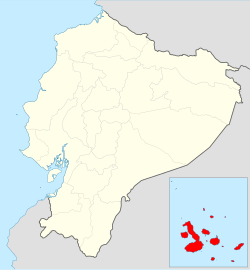Galapagos Province
|
Galápagos Provincia de Galápagos |
||
|---|---|---|
| Province | ||
| Province of Galápagos | ||

Satellite photo of the Galapagos islands
|
||
|
||
| Nickname(s): Archipelago of Galapagos | ||
 Location of Galápagos Province |
||
 Cantons of Galápagos Province |
||
| Coordinates: 0°33′37″S 91°2′27″W / 0.56028°S 91.04083°WCoordinates: 0°33′37″S 91°2′27″W / 0.56028°S 91.04083°W | ||
| Country | Ecuador | |
| Created | February 18, 1973 | |
| Named for | Galápagos Islands | |
| Capital | Puerto Baquerizo Moreno | |
| Cantons |
List of cantons
|
|
| Government | ||
| • Governor | Jorge Torres (2008-) | |
| Area | ||
| • Province | 45,000 km2 (17,000 sq mi) | |
| • Land | 8,010 km2 (3,090 sq mi) | |
| Highest elevation | 1,710 m (5,610 ft) | |
| Lowest elevation | 0 m (0 ft) | |
| Population (2010 census) | ||
| • Province | 25,124 | |
| • Density | 0.56/km2 (1.4/sq mi) | |
| • Urban | 7,475 | |
| Time zone | GALT (UTC-6) | |
| Area code(s) | (0)5 | |
| ISO 3166 code | EC-W | |
| Vehicle registration | W | |
| Languages | Spanish and English | |
| Website | www |
|
Galápagos (Spanish pronunciation: [ɡaˈlapaɣos]) is a province of Ecuador in the country's Insular region, located approximately 1,000 km (620 mi) off the western coast of the mainland. The capital is Puerto Baquerizo Moreno.
The province administers the Galápagos Islands, a group of tiny volcanic islands that sit on the equator. The Galápagos Islands have for centuries captured the interest of people from all over the globe because of its unique biodiversity that was made famous by Charles Darwin and his theory of evolution.
Ethnic groups as of the Ecuadorian census of 2010:
It is estimated that the islands were formed 8 million years ago as a result of tectonic activity on the seabed. The archipelago was likely inhabited long ago: the explorer Thor Heyerdahl in 1963 reported that he found the Inca archaeological sites and objects. The Galapagos Islands were discovered by chance on 10 March 1535, when the Dominican friar Fray Tomas de Berlanga, Bishop of Panama, went to Peru in pursuance of an order of the Spanish monarch, Charles V, to arbitrate in a dispute between Francisco Pizarro and his subordinates after the conquest of the Inca empire. Because of a calm and strong currents, the ship of Bishop was dragged to the Galapagos. In chronicling his adventure, directed from Portoviejo Emperor Charles V on the discovery of the Galapagos Islands, Berlanga described the bleak desert conditions in the islands and the giant tortoises that inhabited them. He also described the marine iguanas, sea lions and many types of birds, emphasizing the unusual mildness of animals and expressed in the following words: It brought the ship very good weather of breezes seven days, that the pilot was making himself near the land and gave us calm six days; the currents were so large, they engulfed us so that Wednesday March 10, we saw an island and because the ship had no more water than for two days, agreed to take the boat and go ashore for water and grass for the horses. And having left, they found nothing but sea lions, turtles and tortoises so big that one could carry a man on top, and many iguanas who are like serpents. Another day we saw another bigger island which is that of large mountains, and believing that there for its greatness as for its monstrosity it could not fail to have rivers and fruits, we went to it, because the first would go down ten or twelve leagues, and in this was drunk the water which there was in the ship and spent three days in taking the island, with calm, in which we men, like the horses suffered many labors there.
...
Wikipedia

